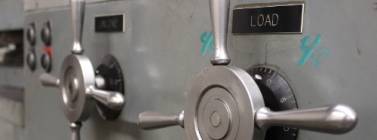What is the difference between F594 and A194 nuts?
For this FAQ, we are focusing on the 304/316 alloys and their common, default strength conditions. Within both F594 and A194, there are many less common, exotic grades and multiple strength conditions. Exploring all possible permutations of all grades would be unnecessarily complicated. For more details, the actual ASTM standards can be purchased from ASTM, or specific questions can be asked of myself or any of our inside salespeople.
The differences between the two standards are primarily mechanical, dimensional, and application-based.
A194 nuts are intended for high-temperature applications, although they are certainly used in many, non-high-temperature applications as well.
F594 nuts are intended for general purpose applications.
We can compare the nuts using three metrics; chemistry, mechanical properties, and dimensions.
Chemically, the nuts are identical. F594 group 1 nuts are made from 304 stainless, as are A194 gr.8 nuts.
F594 group 2 nuts are made from 316 stainless, as are A194 gr.8M nuts.
| A194 gr.8 | A194 gr.8M | F594 Alloy Group 1 | F594 Alloy Group 2 |
| AISI 304 | AISI 316 | AISI 304 | AISI 316 |
Mechanically, there are small differences between the standards.
F594 condition CW – minimum proof load 100ksi up to 5/8” diameter, 85ksi diameters ¾” and up.
A194 – minimum proof load 80ksi for all diameters
| Grade | Proof load, lbf |
|---|---|
| A194 gr. 8, all sizes | 80,000 |
| A194 gr.8M, all sizes | 80,000 |
| F594 CW, sizes up to 5/8” | 100,000 |
| F594 CW, sizes above 5/8” | 85,000 |
Dimensionally, the two nuts are different.
A194 nuts are made to heavy hex dimensions, whereas F594 nuts are made with standard hex dimensions. Heavy hex nuts are 1/8” thicker across the flats regardless of diameter, and are also slightly taller, although that dimension varies by diameter. You can see the size comparisons here:
Standard Hex Nuts
Heavy Hex Nuts
Specials can, of course, be made to alternate dimensions, but the default, off the shelf dimensions, are as above.




What is the largest available size of Type 316 stainless steel coupling nut and is the Type 316 stainless steel coupling nut weldable around its perimeter?
Also is there a Type 316 stainless steel threaded anchor rod that can be used with the Type 316 stainless steel coupling nut? Both the coupling nut and threaded anchor rod would be embedded in concrete beneath a Type 316 stainless steel base plate to which the coupling nut would be welded to the bottom of. Bolts holding down posts sitting on top of the base plate would be threaded into the top of the coupling nuts to hold the post in place on top of the base plate.
@Eric- We have most of our couplers specially made so we are able to supply virtually any diameter. That said, the largest commonly off the shelf sized coupler would be about 1-1/2″ diameter. We are also able to manufacture threaded stainless anchor bolts in almost any diameter. Stainless is typically considered a weldable material, although the addition of heat can alter the corrosion resistance due to its affect on the grain structure, so care should be taken.